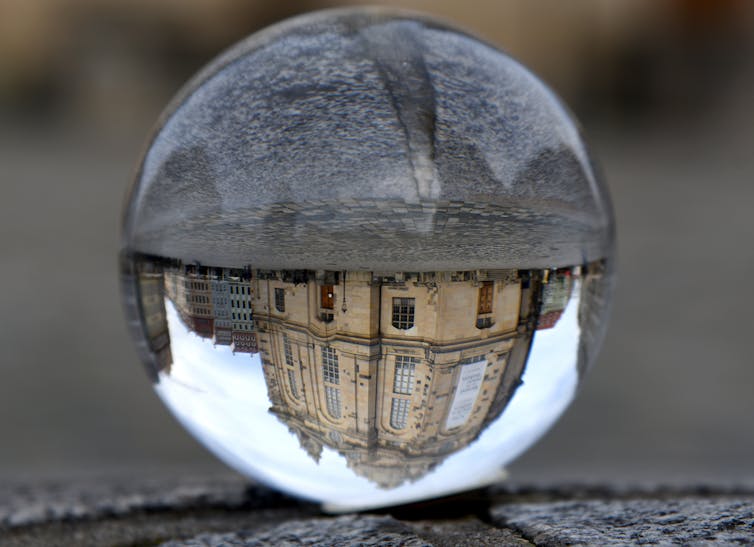Windows on the courtyard: living and thinking under a dome
With the outbreak of the novel coronavirus, the possibility of the end of the world as we know it, that is, the demise of our civilization, has moved beyond the realm of eschatology and alarmist rhetoric to become a topic of discussion in the media, politics, and science.
Abdel Aouacheria, University of Montpellier

Nowadays, any discussion of COVID-19 must include an analysis not only of the threat (viral contamination) but also of our reactions to it and the measures taken to protect ourselves. What are the real limits of the fortifications that are supposed to protect us from collective disintegration? Are protective measures not just the tip of the iceberg, part of a widespread trend toward closure that contrasts with the concepts of globalization and an "open society"?
The emergence of a dystopia
For weeks now, part of humanity has been under house arrest (like photographer Jefferies inside his New York apartment in Rear Window ), on parole, oscillating between two behaviors: withdrawal, justified by the fear of being infected, and the search for refuge. But aren't these two behaviors part of the same process, with deeper roots? A kind of Dômal syndrome? Throughout human evolution, the dome has been both the house (domus) that protects and the roof (doma), the rampart above us that hides the sky. Now, it is a veritable amputecture: the dome protects but amputates its resident's entire horizon, confining them spatially and depriving them of landmarks. The dome functions as a biological membrane, according to Simondon's definition: polarized (interfacing an interior and an exterior) and selective (ensuring that "the living is alive at every moment").
When the dome turns against humans
Admittedly, before SARS-CoV-2, the syndrome was already palpable, but it only had the characteristics of an endemic disease. Think of the international school in Beijing and its shelters allowing children to avoid suffocation, the bunkers of survivalists, or the plant and seed vaults ofthe Eden Project and the Svalbard Seed Vault. Or the construction of walls that isolate countries from one another (Israel from Palestine, the United States from Mexico, etc.).
Seeking to isolate oneself from others, regardless of scale, was still only a matter of NIMBY logic, i.e., a self-defense posture of property owners seeking to protect their interests, as described by Mike Davis in City of Quartz. But what can be done against an invisible enemy that can affect everyone?
What the dome brings into play
Faced with the virus, the dome behaves, as a second characteristic, like an immune system. With Covid-19, the defense of interests has turned into a defense of the social body at all costs. As in the post-apocalyptic film Logan's Run (1976), which depicts a society confined to bubble cities, protection by the dome comes at a high price.
https://www.dailymotion.com/video/x9cajc
The price to pay is a logic of confinement: the dome must become as hermetic as possible. Its purpose is to control the masses in order to perpetuate the whole. In Europe, we quickly saw the closure of the Schengen area and the introduction of controls on the movement of goods and people.
To limit the spread of the pathogen, symbolic or miniature domes were deployed, ranging from the virus to the clan (parents, children, friends), including the establishment of hospital sectors with high and low viral densities, sorting areas, and social distancing (considered synonymous with physical distancing). The à la carte lifting of lockdown restrictions is itself a dome program, based on statistical management of deaths and compliance with standards (including in green zones).
A confusing cacophony
By influencing behavior and living environments, the health crisis provides a case study for Foucault's theory of biopolitics, bringing to life the dystopia depicted in The Crystal Age. In this film, a computer controls the life and death of humans, who have become ignorant of the outside world (which they had rendered uninhabitable) and the very reasons for their confinement in domes.
However, governmentality through the dome is struggling to express itself in the current circumstances: there is confusion about the availability and usefulness of masks and tests, the legitimacy of treatments (e.g., chloroquine), political decisions (scientific advice, the role of experts, the media), and the existence of contradictory injunctions that place citizens in a paradoxical situation (e.g., sending their children to school but not going to restaurants; promoting teleworking while being wary of videoconferencing tools such as Zoom).
These blunders, which affect both discourse (sometimes reassuring, sometimes worrying) and therapeutic practices (with suspicions of collusion with private interests) and preventive measures (with the omission of the precautionary principle embodied by the health reserve), undermine the effects of the normalization of behavior attempted by the authorities. The latter seeks salvation in technology, with the tracking of patients and their contacts. In The Crystal Age, citizens carry a connected crystal in the palm of their hand throughout their lives, like a kind of electronic bracelet.
The state is therefore opening a Pandora's box of liberticidal measures, likely under the control of GAFAM, while investing in both physical space (through the use of drones) and cyberspace (with the omnipresence of the hashtag #StayHome, reminiscent of the propaganda described in the novel 1984 or the film THX 1138).
Architectural domes, reflections of cognitive and sociocultural domes
The mistakes made in managing Covid-19 have undermined public confidence and fostered mistrust, denunciation (in We by Yevgeny Zamyatin, glass buildings enable the spying on and subjugation of dissenters) and conspiracy theories on social media. Here again, the dome metaphor can be used to describe digital echo chambers, whose filter bubbles isolate internet users from ideas that differ from their own, thereby reinforcing their beliefs.

AdobeStock, Author provided
The thing is, domes aren't just external, they're also internal. Cracking them open is risky. By undermining our certainties and conditioning, the crisis reinforces our anxiety about the limitations of a (neoliberal) model that is unable to compensate for the decline of the great ideologies, but which is already looking ahead to the day after, or even the day after that (seethe hearing of military historian Pierre Razoux).
Towards a more united humanity?
The pandemic, because it corresponds to the occurrence of an unforeseen event, accelerates the construction of citadels, both within ourselves and outside, revealing the stigmata of civilizational apoptosis (apoptosis being the process by which a cell, isolated from the rest, destroys itself).
See also:
What is a "crisis"?
Added to this risk of mass suicide is that of hikikomori: the apoptosis of individuals induced by social withdrawal. However, this crisis will have had beneficial effects on our cities and the environment, which will be temporarily depolluted and rewilded. Construction projects are being launched, and dynamic forces are mobilizing to co-construct change, as Edgar Morin had envisioned in La Voie.
This virus reminds us that the outcome of the human adventure on this planet, this pale blue dot (immortalized by the Voyager 1 probe) whose limits and finite resources we are aware of, is not predetermined. Like the DeepDream dream machine, which we can ask to "give us more of whatever you see!", humans today have a duty to promote the emergence of a qualitatively more human tomorrow, rather than foreshadowing the seeds of their own zombification.
If there is no definitive escape from the confines of the domes, we must strive to better understand their limits, in order to embark on a permanent quest to discover what lies beyond them.
This article was co-written with Joachim Daniel Dupuis, PhD in philosophy, historian, and specialist in genre cinema. The co-authors published “La biopolitique vue du cinéma : l’âge de cristal” (L’Harmattan, 2018).![]()
Abdel Aouacheria, Biologist, Research Fellow at the CNRS, specialist in cell life and death, University of Montpellier
This article is republished from The Conversation under a Creative Commons license. Readthe original article.